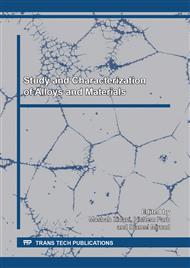[1]
I.V. Ivanov, E. I. Tkachenko, A. Thoemmes, Corrosion Resistance of Medical Stainless Steel Obtained by Non-Vacuum Electron Beam Cladding, Materials Science Forum 946 (2019) 73-78.
DOI: 10.4028/www.scientific.net/msf.946.73
Google Scholar
[2]
J. Baronins, V. Podgursky, M. Antonov, S. Bereznev, I. Hussainova, Electrochemical Behaviour of TiCN and TiAlN Gradient Coatings Prepared by Lateral Rotating Cathode Arc PVD Technology, Key Engineering Materials 721 (2017) 414-418.
DOI: 10.4028/www.scientific.net/kem.721.414
Google Scholar
[3]
R.C. Vega-Morón, G.A. Rodríguez Castro, D.V. Melo-Máximo, J.V. Méndez-Méndez, L. Melo-Máximo, J.E. Oseguera-Peña, A. Meneses-Amador, Adhesion and mechanical properties of Ti films deposited by DC magnetron sputtering, Surface & Coatings Technology 349 (2018) 1137–1147.
DOI: 10.1016/j.surfcoat.2018.05.078
Google Scholar
[4]
A. Nemati, M. Saghafi, S. Khamseh, E. Alibakhshi, P. Zarrintaj, M.R. Saeb, Magnetron-sputtered TiN thin films applied on titanium-based alloys for biomedical applications: Composition-microstructure-property relationships, Surface and Coatings Technology 349 (2018) 251–259.
DOI: 10.1016/j.surfcoat.2018.05.068
Google Scholar
[5]
S. Bauer, P. Schmuki, K. von der Mark, J. Park, Engineering biocompatible implant surfaces, Part I: Materials and surfaces, Progress in Materials Science 58 (2013) 261–326.
DOI: 10.1016/j.pmatsci.2012.09.001
Google Scholar
[6]
H.A. Zaman, S. Sharif, M.H. Idris, A. Kamarudin, Metallic biomaterials for medical implant applications: A Review, Applied Mechanics and Materials 735 (2015) 19-25.
DOI: 10.4028/www.scientific.net/amm.735.19
Google Scholar
[7]
F. Jiang, T.F. Zhang, B.H. Wu, Y. Yu, Y.P. Wu, Sh.F. Zhu, F.J. Jing, N. Huang, Y.X. Leng, Structure, mechanical and corrosion properties of TiN films deposited on stainless steel substrates with different inclination angles by DCMS and HPPMS, Surface & Coatings Technology 292 (2016) 54–62.
DOI: 10.1016/j.surfcoat.2016.03.007
Google Scholar
[8]
Q. Wang, F. Zhou, C. Wang, M. F. Yuen, M. Wang, T. Qian, M. Matsumoto, J. Yan, Comparison of tribological and electrochemical properties of TiN, CrN, TiAlN and a-C:H coatings in simulated body fluid, Materials Chemistry and Physics 158 (2015) 74-81.
DOI: 10.1016/j.matchemphys.2015.03.039
Google Scholar
[9]
S. Grosso, L.L. Romain, G. Berthomé, G. Renou, T. LeCoz, M. Mantel, Titanium and titanium nitride thin films grown by dc reactive magnetron sputtering Physical Vapor Deposition in a continuous mode on stainless steel wires: Chemical, morphological and structural investigations, Surface and Coatings Technology 324 (2017) 318–327.
DOI: 10.1016/j.surfcoat.2017.05.089
Google Scholar
[10]
A. Gilewicz, P. Chmielewska, D. Murzynski, E. Dobruchowska, B. Warcholinski, Corrosion resistance of CrN and CrCN/CrN coatings deposited using cathodic arc evaporation in Ringer's and Hank's solutions, Surface and Coatings Technology 299 (2016) 7–14.
DOI: 10.1016/j.surfcoat.2016.04.069
Google Scholar
[11]
Y.X. Ou, J. Lin, S. Tong, W.D. Sproul, M.K. Lei, Structure, adhesion and corrosion behavior of CrN/TiN superlattice coatings deposited by the combined deep oscillation magnetron sputtering and pulsed dc magnetron sputtering, Surface and Coatings Technology 293 (2016) 21–27.
DOI: 10.1016/j.surfcoat.2015.10.009
Google Scholar
[12]
Y.H. Yang, F.B. Wu, Microstructure evolution and protective properties of TaN multilayer coatings, Surface and Coatings Technology 308 (2016) 108-114.
DOI: 10.1016/j.surfcoat.2016.05.091
Google Scholar
[13]
J. Zuo, Y. Xie, J. Zhang, J. Luo,Y. Wang, Z.M. Yu, Z.G. Tang, TiN coated stainless steel bracket: Tribological, corrosion resistance, biocompatibility and mechanical performance, Surface and Coatings Technology 277 (2015) 227–233.
DOI: 10.1016/j.surfcoat.2015.07.009
Google Scholar
[14]
Z. Lin , S.J Li , F. Sun , D.C Ba , X.C Li, Surface characteristics of a dental implant modified by low energy oxygen ion implantation, Surface & Coatings Technology 365 (2019) 208–213.
DOI: 10.1016/j.surfcoat.2018.09.003
Google Scholar
[15]
K. Shukla, R. Rane, J. Alphonsa, P. Maity, S. Mukherjee, Structural, mechanical and corrosion resistance properties of Ti/TiN bilayers deposited by magnetron sputtering on AISI 316L, Surface and Coatings Technology 324 (2017) 167–174.
DOI: 10.1016/j.surfcoat.2017.05.075
Google Scholar
[16]
S. A. Naghibi, K. Raeissi, M. H. Fathi, Corrosion and tribocorrosion behavior of Ti/TiN PVD coating on 316L stainless steel substrate in Ringer's solution, Materials Chemistry and Physics 148 (2014) 614-623.
DOI: 10.1016/j.matchemphys.2014.08.025
Google Scholar
[17]
W.Y. Wu, M.Y. Chan, Y.H. Hsu, G.Z. Chen, S.C. Liao, C.H. Lee , P.W. Lui, Bioapplication of TiN thin flms deposited using high power impulse magnetron sputtering, Surface and Coatings Technology 362 (2019) 167–175.
DOI: 10.1016/j.surfcoat.2019.01.106
Google Scholar
[18]
K. Vasu, M. Ghanashyam Krishna, K. A. Padmanabhan, substrate-temperature dependent structure and composition variation in RF magnetron sputtered titanium nitrid thin films, Applied Surface Science, 257 (2011) 3069-3074.
DOI: 10.1016/j.apsusc.2010.10.118
Google Scholar
[19]
S. Datta, M. Das, V.K. Balla, S. Bodhak, V.K. Murugesan, Mechanical, wear, corrosion and biological properties of arc deposited titanium nitride coatings, Surface and Coatings Technology 344 (2018) 214–222.
DOI: 10.1016/j.surfcoat.2018.03.019
Google Scholar
[20]
K. Wen-Hsien, S. Yean-Liang, H. Jeng-Haur, Yun-Ting Hsieh, Improved tribological properties, electrochemical resistance and biocompatibility of AISI 316L stainless steel through duplex plasma nitriding and TiN coating treatment, Journal of Biomaterials Applications 32(1) (2017) 12–27.
DOI: 10.1177/0885328217712109
Google Scholar
[21]
R.C. Vega-Morón, G.A. Rodríguez Castro, D.V. Melo-Máximo, J.V. Méndez-Méndez, L. Melo-Máximo, J.E. Oseguera-Peña, A. Meneses-Amador, Adhesion and mechanical properties of Ti films deposited by DC magnetron T sputtering, Surface & Coatings Technology 349 (2018) 1137–1147.
DOI: 10.1016/j.surfcoat.2018.05.078
Google Scholar
[22]
C. Sha, Z. Zhou, Z. Xie, P. Munroe, Scratch response and tribological behaviour of CrAlNiN coatings deposited by closed field unbalanced magnetron sputtering system, Surface and Coatings Technology 367 (2019) 30–40.
DOI: 10.1016/j.surfcoat.2019.03.053
Google Scholar
[23]
M. Zawischa, S. Makowski, N. Schwarzer, V. Weihnach, Scratch resistance of superhard carbon coating, A new approach to failure and adhesion evaluation, Surface & Coatings Technology 308 (2016) 341-348.
DOI: 10.1016/j.surfcoat.2016.07.109
Google Scholar



